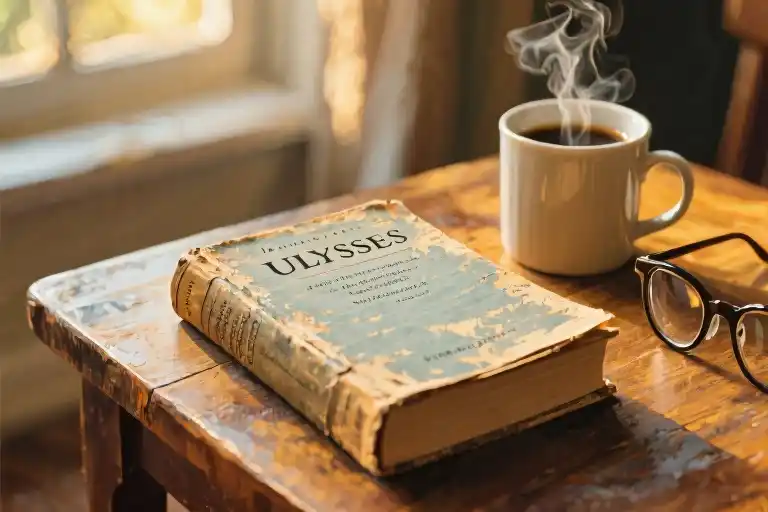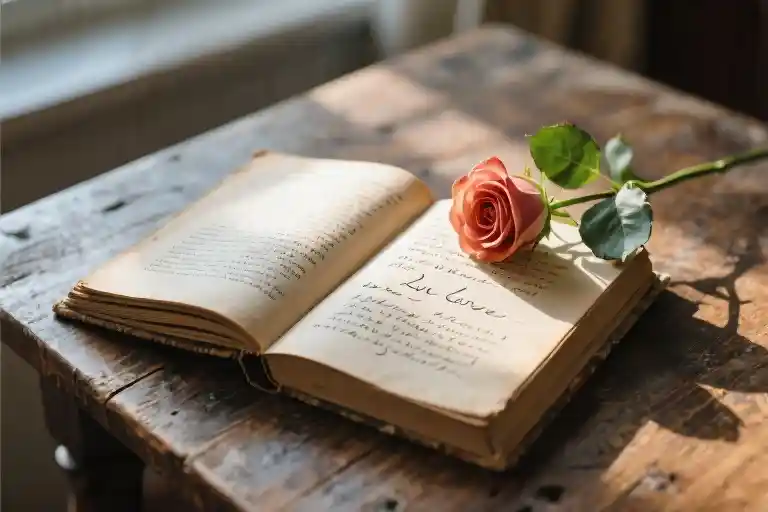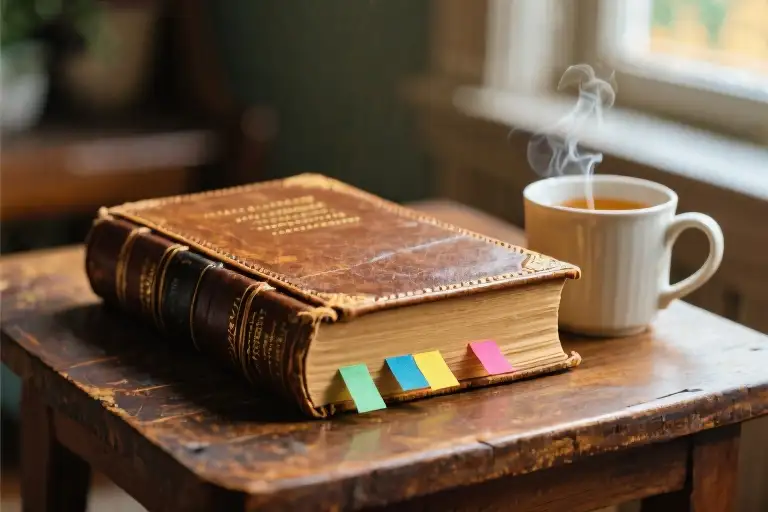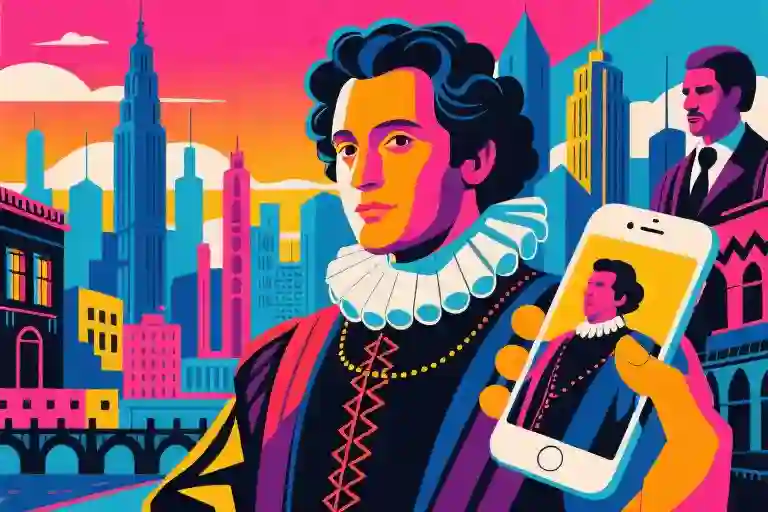What’s my favorite book, you ask? Well, I’d say it’s James Joyce’s Ulysses—yes, that famously “unreadable” masterpiece collecting dust on so many bookshelves. Before you recoil at the mention of its difficulty, let me share a secret: the real barrier isn’t the book itself, but the intimidating reputation we’ve wrapped around classics like a suffocating academic straitjacket.
We’ve all heard the whispers: “Ulysses requires a PhD to understand,” or “You’ll need three guidebooks just to get through Chapter 1.” Literary circles have turned appreciation into an exclusive club where nodding sagely at obscure references matters more than the raw experience of reading. But here’s the truth—Joyce himself once said he stuffed his novel with “so many enigmas and puzzles that it will keep the professors busy for centuries arguing over what I meant.” He was trolling the very elites who now gatekeep his work.
The term “classic literature for beginners” shouldn’t be an oxymoron. When we label books as inherently difficult (looking at you, Finnegans Wake), we rob them of their vitality. Think about it: no one warns you to study medieval cosmology before enjoying Dante’s Inferno, yet we’ve convinced generations that Ulysses demands prep work. That 200-page introduction in your edition? Toss it. The footnotes comparing Bloom’s lunch to Homer’s Odyssey? Skip ‘em. Start on page one and let the language wash over you—the rhythm of Dublin’s streets in the morning, the humor in Bloom’s inner monologue, the sheer musicality of phrases like “the snotgreen sea.
I’ll never forget my first attempt, aged 19, when I dutifully read three literary analyses before daring to open the novel… only to abandon it after 30 pages of anxiety. Years later, I picked it up on a whim during a train delay, no annotations in sight, and suddenly—magic. Without the pressure to “decode” it, I noticed how Joyce captures the chaos of human thought with startling warmth. That’s when I realized: difficult books made simple aren’t about reducing complexity, but reclaiming the right to engage with it on your own terms.
So here’s your rebellion starter pack:
- Physical book > e-reader (resist the Ctrl+F footnote temptation)
- Set a 20-minute timer—read first, Google later
- Embrace confusion (even scholars debate Joyce’s “correct” meanings)
- Join the blasphemers—highlight passages that move you, even if they’re “not the important parts”
Remember, Ulysses was once banned for being too obscene, not too intellectual. Its power lies in the messy humanity Bloom embodies—a middle-aged ad salesman navigating love, loss, and petty grievances. That’s not a puzzle to solve; it’s a mirror to experience. As one non-academic reader told me, “I don’t know what ‘stream of consciousness’ means, but Bloom’s rambling thoughts about his wife? That’s exactly how my brain works.”
So let’s retire the myth that classics require special permission to enjoy. Your interpretation—flawed, personal, gloriously unacademic—is just as valid as any professor’s. Now grab that intimidating book you’ve been avoiding, turn to page one, and read like no one’s grading you.
The Myth of Difficulty: Who Says Classics Must Be Hard?
We’ve all been there – standing in a bookstore, fingers brushing against the spine of a literary classic, only to recoil at the whispered warnings: “That one’s impossible to understand”, “You’ll need a professor to explain it”, “I tried reading it in college and gave up after 10 pages”. According to a recent survey by the National Endowment for the Arts, 82% of readers admit avoiding certain classics solely because of their intimidating reputation. But here’s the uncomfortable truth: the difficulty of books like Ulysses often says more about our cultural conditioning than the text itself.
The Academic Industrial Complex
Consider how we’re introduced to literary classics: typically through 50-page scholarly introductions that read like legal disclaimers (“Before experiencing this art, please review these 12 critical theories”). University literature courses frequently teach books backward – starting with interpretations before letting students encounter the raw text. The result? We’ve created a system where appreciating Mrs. Dalloway requires more prep work than assembling IKEA furniture.
Publishing trends reinforce this. Notice how new editions of Moby Dick increasingly resemble textbooks – with footnotes sometimes exceeding the original text. As critic Harold Bloom observed, “We’ve made a sacrament of difficulty”, creating a self-perpetuating cycle where:
- Academics produce complex analyses to demonstrate expertise
- Publishers market books as “challenging” to appear prestigious
- Media amplifies the “unreadable masterpiece” narrative
- Readers internalize these messages as absolute truth
Case Study: Two Crime and Punishments
Compare these real-world reading experiences:
University Seminar
- Week 1: 90-minute lecture on 19th-century Russian nihilism
- Week 2: Symbolism of Raskolnikov’s axe (45 PowerPoint slides)
- Week 3: Student drops course after failing to “get it”
Neighborhood Book Club
- Meeting 1: “That scene where he hides the money had me sweating!”
- Meeting 2: “Sonya reminds me of my cousin who…”
- Outcome: 8/10 members finish the novel, 3 reread it voluntarily
The difference? One approach treats literature as a code to crack, the other as human experience to share. As Virginia Woolf (herself often labeled “difficult”) wrote in her diary: “Never let anyone tell you what to think about a book – not even me.”
Rewriting the Narrative
Modern psychology confirms what avid readers know instinctively: our brains process stories differently when reading for pleasure versus analysis. fMRI studies show that:
- Pressure to interpret activates stress-related brain regions
- Curiosity-driven reading enhances connectivity in imagination networks
This explains why many “impossible” books become approachable when we:
- Encounter them outside academic contexts
- Read at our own pace without “correct answer” anxiety
- Allow personal connections to form organically
Next time you hear “That book’s too hard”, ask yourself: Is the text truly inaccessible, or have we been taught to approach it with unnecessary reverence? The most radical act might be simply reading it like any other story – one page at a time, without special preparation. After all, James Joyce himself reportedly said: “I’ve put in so many enigmas and puzzles that it will keep the professors busy for centuries arguing over what I meant – that’s the only way to ensure one’s immortality.” Perhaps the real joke’s on the experts.
Rebel Reading Rules: How to Enjoy Ulysses Without a PhD
Let’s be honest – most academic introductions to classic literature read like instruction manuals for assembling furniture. By the time you finish the 50-page preface analyzing every possible interpretation of Leopold Bloom’s hat, you’ve forgotten why you wanted to read the book in the first place.
Rule #1: Toss the Introductions (Seriously)
Here’s a radical idea: Try reading Ulysses like Joyce’s original audience did – without any scholarly baggage. Those lengthy introductions claiming to ‘prepare’ you? They’re often what makes the book feel intimidating. As one book club member told me: ‘When I skipped the 30-page analysis and just started with “Stately, plump Buck Mulligan,” suddenly I was swimming in the language instead of drowning in footnotes.’
Three reasons to ditch the pre-game show:
- Preserves your first impressions – No one ‘prepares’ you before watching a sunset
- Encourages personal connections – Your uncle might remind you more of Bloom than any critic’s analysis
- Makes it actually enjoyable – Reading shouldn’t feel like homework
Rule #2: Embrace the ‘I Don’t Get It’ Moments
That famous stream-of-consciousness passage in Episode 3? Treat it like abstract jazz – you don’t need to ‘understand’ every note to feel its rhythm. Here’s how real readers handle difficult sections:
- The Music Method: Read aloud to catch the musicality (Joyce loved singing these passages)
- The Post-It Approach: Mark confusing bits to revisit later – often they’ll make sense in context
- The 20-Minute Rule: Force yourself to read uninterrupted for 20 minutes before checking annotations
“I stopped stressing about ‘getting’ every reference. Once I relaxed, the Dublin pub scenes felt as familiar as my local bar.”
— Mark, engineer and first-time Joyce reader
Your Rebel Reading Toolkit
- The Chapter Cheat Sheet (Downloadable PDF)
- One-sentence scene summaries
- Map of Bloom’s Dublin wanderings
- No spoilers, just orientation
- The Joycean Survival Kit
- Good tea/coffee (hydration helps with long sentences)
- Notebook for your own connections
- Colored tabs to mark favorite passages
- Progress Tracker
- Celebrate small wins (Episode 1 complete!)
- Recommended pace: 5-10 pages per sitting
Remember: There’s no test at the end. If a passage speaks to you, that’s the ‘correct’ reading. As Joyce himself said: “The demand that I make of my reader is that he should devote his whole life to reading my works.” Just kidding – he never said that. See? Even the experts make things up.
Download Rebel Reader’s Checklist | Printable Dublin Map
Real Stories from Real Readers
Let’s cut through the academic jargon and meet people who actually read Ulysses—not as a PhD thesis, but as an ordinary book. These aren’t literature professors; they’re retirees, tech workers, and curious minds who decided to approach Joyce’s masterpiece on their own terms. Their stories prove one thing: you don’t need a decoder ring to enjoy classic literature.
Mary’s Breakfast Ritual: 2 Pages a Day
Mary, a 68-year-old retired biology teacher, tackled Ulysses like she tended her garden—little and often.
“I kept hearing it was impossible, so I made a game of it. Every morning with my coffee, I’d read exactly two pages—no more, no less. Some days I understood nothing. Other days, Bloom’s thoughts felt like chatting with an old friend. After six months, I finished… and immediately restarted.”
Her secret? Embracing confusion. When stream-of-consciousness passages overwhelmed her, she’d jot down sensory impressions instead of hunting for “meaning” (“That paragraph smelled like burnt toast!”). By the second read, patterns emerged naturally.
Keyword integration: reading Ulysses without studying, classic literature for beginners
Alex the Programmer: Debugging Dublin
Alex, a 32-year-old software engineer, treated Ulysses like a complex algorithm:
- Isolate variables: He ignored footnotes and focused on one chapter at a time.
- Run tests: Highlighted recurring motifs (e.g., “What’s up with all the kidneys?”).
- Accept glitches: “Not every function needs documentation—sometimes you just enjoy the output.”
His breakthrough? Mapping Bloom’s wanderings onto his commute: “When he stops for a burger, I pictured my local diner. Suddenly, 1904 Dublin felt like my neighborhood.”
Tool tip: He used a color-coded Kindle highlight system (yellow = food references, blue = music) to spot connections.
Keyword integration: James Joyce easy guide, difficult books made simple
The Crowdsourced Bloom Map
Online, non-academic readers have reinvented how we visualize classics. One Reddit thread compiled hand-drawn maps of Leopold Bloom’s June 16, 1904 journey:
- A barista sketched it as a coffee-stained subway map
- A nurse charted it like a patient’s vitals (peaks = chaotic chapters)
- A delivery driver tracked mileage between stops
Why this works: It transforms an “intellectual” book into a tactile, personal experience. As one participant said: *”My map is wrong according to scholars… but it’s *my* Dublin.”*
Keyword integration: real people reading Ulysses, how to enjoy Ulysses without studying it
Your Turn: Start Small, Stay Curious
These readers succeeded because they:
- Chose their own entry point (food scenes? slang? just the dialogue?)
- Allowed imperfect understanding (“I still don’t get Episode 3, but Episode 8 made me cry”)
- Made it relevant (linked Bloom’s thoughts to their own memories)
“Classics aren’t locked doors—they’re gardens where everyone picks different flowers.”
—Mary, after her third reread
Action prompt: *Tonight, open *Ulysses* to any page. Read one paragraph. What does it remind you of—not what it “means”?*
Your Classic Rebellion Reading List
Now that we’ve debunked the myth that classics need to come with an instruction manual, let’s explore some other magnificent works that have been unfairly labeled as ‘difficult.’ These five books don’t require a literature degree to enjoy – just your curiosity and willingness to dive in. I’ve paired each with real comments from ordinary readers who dared to try them.
1. In Search of Lost Time by Marcel Proust
Reader’s Verdict: “I thought it would be stuffy, but Proust writes about childhood memories in a way that made me smell my grandmother’s kitchen again.” – Sarah, graphic designer
Yes, it’s seven volumes. No, you don’t need to read them all at once. Treat each book like a separate conversation with a brilliant friend who notices everything you’ve felt but never articulated. Start with Swann’s Way and let Proust’s famous madeleine passage show you how literature can awaken forgotten sensations.
2. To the Lighthouse by Virginia Woolf
Reader’s Verdict: “At first the sentences seemed to go on forever, then suddenly I was inside the characters’ minds in a way no movie could show.” – David, nurse
Woolf’s stream-of-consciousness style isn’t a barrier – it’s an invitation to experience thoughts as they actually flow. The ‘difficult’ parts often contain the most profound observations about time, relationships, and the quiet moments that shape our lives.
3. Moby-Dick by Herman Melville
Reader’s Verdict: “Skip the whale biology chapters if you want – the story of Ahab’s obsession kept me up at night.” – Jamal, high school teacher
This isn’t just a novel about a whale hunt; it’s about the terrifying beauty of human obsession. The technical chapters (which even scholars debate skipping) make perfect bathroom reading – dip in and out as you please while following the gripping main narrative.
4. The Sound and the Fury by William Faulkner
Reader’s Verdict: “The first section confused me, but by the end I understood exactly why Faulkner wrote it that way – genius!” – Elena, barista
Faulkner’s experimental structure mirrors how memory actually works – fragmented, emotional, and making perfect sense in retrospect. Push through the initial disorientation and you’ll be rewarded with one of American literature’s most powerful family sagas.
5. Gravity’s Rainbow by Thomas Pynchon
Reader’s Verdict: “I stopped trying to ‘get’ every reference and just enjoyed the wild ride. It’s like a psychedelic war movie in book form.” – Ryan, software engineer
Pynchon’s postmodern masterpiece works best when you surrender to its chaotic energy rather than stressing about catching every historical allusion. The plot matters less than the unforgettable scenes and language that will stick with you for years.
Rebel Reading Tip: Create your own ‘difficult books made simple’ list. Notice which classics intimidate you, then challenge that fear by reading just the first chapter. You might discover that what seemed unreadable becomes unputdownable when approached on your own terms.
The Last Page Is Just the Beginning
Now comes the simplest yet most radical step: pick up that “intimidating” classic gathering dust on your shelf and start reading—tonight. Not after you’ve finished the companion guide, not when you’ve cleared your schedule for a “serious reading session,” but right now, even if it’s just for five minutes before bed. The greatest rebellion against literary elitism begins with turning to page one (or fifty-three, or two hundred—we don’t do rules here).
Remember Mary, our retired teacher who conquered Ulysses two pages at breakfast? She told me something profound: “I used to think I needed special glasses to see what made classics ‘great.’ Turns out all I needed was to stop listening to people telling me what glasses to wear.” That’s the magic of direct reading—you trade prescribed meanings for personal discoveries. When Alex the programmer approached Joyce’s novel like debugging code, he found patterns no literature professor had ever pointed out.
Here’s your final challenge: Read the next classic your way. Underline passages that make you laugh without knowing why. Sketch doodles in the margins when scenes spark your imagination. Let your confusion sit comfortably instead of rushing to Google. And most importantly—compare what moves you with what critics claim you “should” appreciate. Which interpretation feels richer? Which insights linger longer?
Before you go, I’ll leave you with this thought from a 19-year-old college student who messaged me after reading Moby Dick on a whim: “All those warnings about it being boring made me miss out on the funniest book I’ve ever read… until I decided to find out for myself.”
Your literary adventure starts where others stop—at the edge of expectation. Now close this article, open that book, and meet me on the other side. I’ll be waiting to hear what you discovered.





